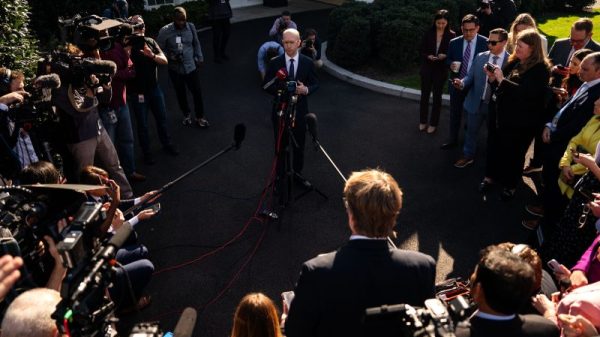The last batch of inflation news that Federal Reserve officials will see before their policy meeting next week is in, and none of it is very good.
In the aggregate, Commerce Department indexes that the Fed relies on for inflation signals showed prices continuing to climb at a rate still considerably ahead of the central bank’s 2% annual goal, according to separate reports this week.
Within that picture came several salient points: An abundance of money still sloshing through the financial system is giving consumers lasting buying power. In fact, shoppers are spending more than they’re taking in, a situation neither sustainable nor disinflationary. Finally, consumers are dipping into savings to fund those purchases, creating a precarious scenario, if not now then down the road.
Put it all together, and it adds up to a Fed likely to be cautious and not in the mood anytime soon to start cutting interest rates.
“Just spending a lot of money is creating demand, it’s creating stimulus. With unemployment under 4%, it shouldn’t be that surprising that prices aren’t” going down, said Joseph LaVorgna, chief economist at SMBC Nikko Securities. “Spending numbers aren’t going down anytime soon. So you might have a sticky inflation scenario.”
Indeed, data the Bureau of Economic Analysis released Friday showed that spending outpaced income in March, as it has in three of the past four months, while the personal savings rate plunged to 3.2%, its lowest level since October 2022.
At the same time, the personal consumption expenditures price index, the Fed’s key measure in determining inflation pressures, moved up to 2.7% in March when including all items, and held at 2.8% for the vital core measure that takes out more volatile food and energy prices.
A day earlier, the department reported that annualized inflation in the first quarter ran at a 3.7% core rate in the first quarter in total, and 3.4% on the headline basis. That came as real gross domestic product growth slowed to a 1.6% pace, well below the consensus estimate.
The stubborn inflation data raised several ominous specters, namely that the Fed may have to keep rates elevated for longer than it or financial markets would like, threatening the hoped-for soft economic landing.
There’s an even more chilling threat that should inflation really persist, central bankers may have to not only consider holding rates where they are but also contemplate future hikes.
“For now, it means the Fed’s not going to be cutting, and if [inflation] doesn’t come down, the Fed’s either going to have to hike at some point or keep rates higher for longer,” said LaVorgna, who was chief economist for the National Economic Council under former President Donald Trump. “Does that ultimately give us the hard landing?”
The inflation problem in the U.S. today first emerged in 2022, and had multiple sources.
At the beginning of the flare-up, the issues came largely from supply chain disruptions that Fed officials thought would go away once shippers and manufacturers had the chance to catch up as pandemic restrictions eased.
But even with the Covid economic crisis well in the rear view mirror, Congress and the Biden administration continue to spend lavishly, with the budget deficit at 6.2% of GDP as of the end of 2023. That’s the highest outside of the Covid years since 2012 and a level generally associated with economic downturns, not expansions.
On top of that, a still-bustling labor market, in which job openings outnumbered available workers at one point by a 2 to 1 margin and are still at about 1.4 to 1, also helped keep wage pressures high.
Now, even with demand shifting back from goods to services, the normal state of the U.S. economy, inflation remains elevated and is confounding the Fed’s efforts to slow demand.
Fed officials had thought inflation would ease this year as housing costs subsided. While most economists still expect an influx of supply to pull down shelter-related prices, other areas have cropped up.
For instance, core PCE services inflation excluding housing — a relatively new wrinkle in the inflation equation nicknamed “supercore” — is running at a 5.6% annualized rate over the past three months, according to Mike Sanders, head of fixed income at Madison Investments.
Demand, which the Fed’s rate hikes were supposed to quell, has remained robust, helping drive inflation and signaling that the central bank may not have as much power as it thinks to bring down the pace of price increases.
“If inflation remains higher, the Fed will be faced with the difficult choice of pushing the economy into a recession, abandoning its soft landing scenario, or tolerating inflation higher than 2%,” Sanders said. “To us, accepting higher inflation is the more prudent option.”
Thus far, the economy has managed to avoid broader damage from the inflation problem, though there are some notable cracks.
Credit delinquencies have hit their highest level in a decade, and there’s a growing unease on Wall Street that there’s more volatility to come.
Inflation expectations also are on the rise, with the closely watched University of Michigan consumer sentiment survey showing one- and five-year inflation expectations respectively at annual rates of 3.2% and 3%, their highest since November 2023.
No less a source than JPMorgan Chase CEO Jamie Dimon this week vacillated from calling the U.S. economic boom “unbelievable” on Wednesday to a day letter telling the Wall Street Journal that he’s worried all the government spending is creating inflation that is more intractable than what is currently appreciated.
“That’s driving a lot of this growth, and that will have other consequences possibly down the road called inflation, which may not go away like people expect,” Dimon said. “So I look at the range of possible outcomes. You can have that soft landing. I’m a little more worried that it may not be so soft and inflation may not go quite the way people expect.”
Dimon estimated that markets are pricing in the odds of a soft landing at 70%.
“I think it’s half that,” he said.




























